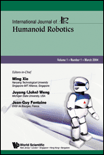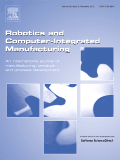
Robotic Intelligence and Automation
Scope & Guideline
Innovating at the Intersection of Robotics and Technology.
Introduction
Aims and Scopes
- Robotic Control Systems:
Research in this area emphasizes the development of advanced control algorithms for various robotic systems, including soft robots, exoskeletons, and autonomous vehicles, focusing on enhancing precision and adaptability. - Machine Learning and AI in Robotics:
A core focus on integrating machine learning techniques, such as reinforcement learning and neural networks, to improve robotic decision-making, perception, and task execution. - Human-Robot Interaction:
Studies aimed at improving collaboration between humans and robots, including task planning and execution, which enhance productivity and safety in shared environments. - Robotic Perception and Sensing:
Research on advanced sensing technologies and perception algorithms that enable robots to understand and interact with their environments effectively. - Robotic Assembly and Manufacturing:
Innovations in robotic assembly techniques, including optimization methods for manufacturing processes and assembly line scheduling, to enhance efficiency and accuracy. - Underwater and Aerial Robotics:
Exploration of specialized applications in underwater and aerial robotics, focusing on unique challenges and solutions in these environments.
Trending and Emerging
- Adaptive and Smart Control Systems:
There is an increasing trend towards adaptive control methods that allow robots to learn and modify their behavior in real-time, enhancing their operational efficiency in dynamic environments. - Collaborative Robotics:
Research on collaborative robots (cobots) that work alongside humans is gaining traction, focusing on enhancing safety, efficiency, and productivity in various industries. - Digital Twin and Simulation Technologies:
Emerging interest in digital twin technologies for simulating robotic systems and processes, enabling better planning, monitoring, and optimization of robotic operations. - Robotic Learning from Demonstration:
Growing focus on robots that learn tasks through human demonstration, which is crucial for tasks that require intricate manipulation and adaptability. - Bio-inspired Robotics:
An emerging trend in designing robots that mimic biological systems, leading to innovative solutions in mobility, manipulation, and environmental interaction. - Sustainable Robotics Solutions:
Increased emphasis on developing robotic systems that contribute to sustainability, including energy-efficient designs and applications in renewable energy sectors.
Declining or Waning
- Traditional Manufacturing Automation:
Research focused on conventional automation methods appears to be declining as more emphasis is placed on intelligent and adaptive systems that leverage AI and machine learning. - Basic Robotics Theory:
There is a noticeable reduction in publications centered around foundational theories in robotics, as the field moves towards applied research with immediate practical implications. - Simple Robotic Applications:
Studies exploring basic robotic applications with limited complexity are becoming less frequent, with a shift towards more sophisticated and integrated robotic solutions.
Similar Journals

Frontiers in Neurorobotics
Unlocking the Potential of Robotics with Neural ScienceFrontiers in Neurorobotics is a leading open access journal that bridges the fields of artificial intelligence and biomedical engineering, dedicated to advancing the understanding and application of neural mechanisms in robotics. Published by FRONTIERS MEDIA SA in Switzerland, this journal has been disseminating innovative research since its inception in 2007. With an aim to foster interdisciplinary collaboration and share cutting-edge findings, Frontiers in Neurorobotics holds a commendable position in the academic landscape, ranking in the Q2 category for both Artificial Intelligence and Biomedical Engineering as of 2023. Researchers will find it particularly valuable due to its broad scope, which encompasses everything from theoretical frameworks to practical applications in neurorobotics. The journal is committed to open access, ensuring that its contents are readily available to a global audience, thus enhancing visibility and engagement with trailblazing research in this dynamic field.

Journal of Robotics Networking and Artificial Life
Pioneering Research in Robotics and Artificial Intelligence.Journal of Robotics Networking and Artificial Life, published by ALife Robotics Corp Ltd, stands at the forefront of interdisciplinary research at the intersection of robotics, artificial intelligence, and networking, representing a vital resource for scholars and practitioners in these rapidly evolving fields. Established as an Open Access journal since 2014, it provides unrestricted access to cutting-edge research and innovative methodologies, fostering collaboration and knowledge dissemination globally. Although it currently holds a Q4 ranking in both Artificial Intelligence and Computer Networks and Communications, its commitment to advancing knowledge through robust peer review and dedicated publication practices positions it as a growing contender within these spheres. With a publication history covering the years from 2019 to 2023, this journal emphasizes the importance of novel insights and cross-disciplinary approaches. Researchers, professionals, and students are encouraged to contribute to and engage with the evolving discourse in robotics and artificial intelligence, making the Journal of Robotics Networking and Artificial Life an essential addition to their academic and professional resources.

International Journal of Humanoid Robotics
Unveiling the Potential of Humanoid InnovationInternational Journal of Humanoid Robotics, published by World Scientific Publishing Co Pte Ltd, is a leading platform for researchers and practitioners in the fields of artificial intelligence and mechanical engineering. With an ISSN of 0219-8436 and an E-ISSN of 1793-6942, this journal has established itself as a significant resource since its inception in 2004. Spanning various topics from robotic design and control to human-robot interaction, it serves a diverse interdisciplinary audience. The journal’s impressive ranking in the Scopus database, positioned in the third quartile for both categories in 2023, reflects its growing impact in the academic community. Although not open access, the journal provides crucial insights that advance the understanding of humanoid robotics and foster innovative solutions to real-world challenges. Researchers, professionals, and students are encouraged to engage with this essential resource as it continues to shape the future of robotics through rigorous scientific inquiry and scholarly collaboration.

Frontiers in Robotics and AI
Shaping Tomorrow's Technologies with Cutting-Edge ResearchFrontiers in Robotics and AI is a leading journal dedicated to the exploration and dissemination of groundbreaking research in the fields of robotics and artificial intelligence. Published by FRONTIERS MEDIA SA in Switzerland, it has established itself as a vital resource for academics, professionals, and students since its inception in 2014. With an impressive Open Access model, the journal ensures that high-quality research is accessible to a global audience, fostering collaboration and innovation. The journal is recognized for its distinguished impact in the academic community, achieving Q2 quartile rankings in both Artificial Intelligence and Computer Science Applications as of 2023. It currently holds a solid position in Scopus rankings, with a rank of #123 out of 350 in Artificial Intelligence and #223 out of 817 in Computer Science Applications, reflecting its robust contribution to these dynamic disciplines. The journal's scope encompasses a wide range of topics, including but not limited to autonomous systems, machine learning, and human-robot interaction, making it an essential platform for innovative ideas and advanced research.

Intelligent Service Robotics
Transforming Tomorrow: Unleashing the Power of Intelligent RoboticsIntelligent Service Robotics, published by SPRINGER HEIDELBERG, is a leading journal that focuses on the transformative intersection of intelligent systems and robotics, establishing itself as a pivotal resource for researchers, professionals, and students in the fields of Artificial Intelligence, Computational Mechanics, and Mechanical Engineering. With an impressive impact factor reflective of its relevance—featuring a 2023 Q1 ranking in Computational Mechanics and Mechanical Engineering, and Q2 in Artificial Intelligence—this journal disseminates high-quality, peer-reviewed research that propels innovation and application in various engineering disciplines. Operating from its headquarters in Heidelberg, Germany, Intelligent Service Robotics aims to foster a dynamic academic community, encouraging open dialogue and collaboration among thought leaders and emerging scholars alike. The journal invites submissions that provide novel insights and solutions in the rapidly evolving landscape of service robotics, ensuring that it remains at the forefront of scientific discourse. With a converged publication timeline from 2008 to 2024 and robust Scopus rankings, the journal is committed to shaping the future of robotic intelligence and its applications.

ROBOTICS AND COMPUTER-INTEGRATED MANUFACTURING
Elevating Industry Standards with Cutting-Edge ResearchROBOTICS AND COMPUTER-INTEGRATED MANUFACTURING is a prestigious, peer-reviewed journal published by PERGAMON-ELSEVIER SCIENCE LTD. With an impressive impact factor and rankings placing it in the Q1 quartile across multiple categories, including Computer Science Applications, Control and Systems Engineering, and Industrial and Manufacturing Engineering, this journal is a leading source for cutting-edge research in its field. Since its inception in 1984 and covering a broad range of topics until 2025, it provides an essential platform for scholars and practitioners aiming to explore innovative technologies and methodologies that integrate robotics and computing in manufacturing processes. Although it does not offer an Open Access option, its rigorous editorial standards and high visibility in academic circles make it a vital resource for anyone seeking to contribute to or stay informed about advancements in these dynamic fields. As an authoritative voice in the landscape of industrial research, ROBOTICS AND COMPUTER-INTEGRATED MANUFACTURING inspires engaging discussions and collaborations among researchers, professionals, and students alike, driving forward the evolution of smart manufacturing solutions.

AUTONOMOUS ROBOTS
Unleashing Potential in Autonomous Technology.AUTONOMOUS ROBOTS, published by SPRINGER, is a leading academic journal that serves as a pivotal platform for the dissemination of cutting-edge research in the field of Autonomous Robotics. With an ISSN of 0929-5593, this esteemed journal has been at the forefront of innovation since its inception in 1994, and it continues to thrive with a vision extending to 2024 and beyond. Recognized in the Q1 category of Artificial Intelligence, it boasts a commendable ranking of #85 out of 350 in Computer Science and Artificial Intelligence, positioning it within the 75th percentile of researchers' preferred publications. The journal features a range of subjects related to autonomous systems, including but not limited to robot perception, action planning, multi-agent systems, and autonomous interactions, catering to an audience that spans researchers, industry professionals, and students alike. Scholars can access a wealth of peer-reviewed articles that contribute to both theoretical frameworks and practical applications, ensuring the relevance of the work published within its pages. Located in Dordrecht, Netherlands, AUTONOMOUS ROBOTS exemplifies a commitment to advancing the science of robotics, making significant contributions to the knowledge base and inspiring new developments within the field.

INTERNATIONAL JOURNAL OF ROBOTICS & AUTOMATION
Advancing the Future of Robotics and Automation.International Journal of Robotics & Automation is a premier academic journal published by ACTA PRESS, dedicated to advancing knowledge and applications in the dynamic fields of robotics, automation, and related engineering disciplines. With a history spanning from 1995 to 2024, this journal serves as a crucial platform for the dissemination of innovative research, offering valuable insights across various categories, including Artificial Intelligence, Control and Systems Engineering, and Mechanical Engineering. Although currently not open access, its rigorous peer-reviewed articles hold significance for researchers, professionals, and students alike, providing a solid foundation for advancements in technology and engineering methodologies. The journal's rankings in Scopus reflect its growing impact, particularly in niche areas of Modeling and Simulation and Software, highlighting the critical need for cutting-edge research and discussion in these developing fields. As the landscape of robotics and automation continues to evolve, this journal remains an essential resource for those seeking to contribute to and engage with the forefront of scholarly research.

International Journal of Automation Technology
Leading the Charge: Your Gateway to Cutting-Edge Automation ResearchWelcome to the International Journal of Automation Technology, a forefront publication in the dynamic fields of Industrial and Manufacturing Engineering and Mechanical Engineering, published by FUJI TECHNOLOGY PRESS LTD. With an ISSN of 1881-7629 and E-ISSN of 1883-8022, this peer-reviewed journal has been embracing the open access model since 2007, allowing researchers worldwide to disseminate and access groundbreaking work. It aims to advance knowledge in automation technology through original research, reviews, and case studies, making contributions that impact both theoretical frameworks and practical applications in automation systems. As reflected in its 2023 Q2 quartile rankings, the journal holds a respectable position among its peers, fostering a vibrant academic community committed to innovation. Situated in Tokyo, Japan, the journal continually seeks to highlight compelling findings that respond to the contemporary challenges facing engineering disciplines, ultimately supporting the growth of automation technologies in various sectors.

Journal of Robotics
Advancing the Future of Robotics ResearchJournal of Robotics, published by HINDAWI LTD, is a premier open-access journal dedicated to the rapidly evolving field of robotics. With its ISSN 1687-9600 and E-ISSN 1687-9619, the journal has been an essential resource for researchers, professionals, and students since its establishment in 2009. Based in England, the journal not only aims to disseminate cutting-edge research but also provides a platform for critical discussions on the latest advancements in robotics. Recognized for its quality, the journal holds a Q2 ranking in Computer Science (miscellaneous) and a Q3 ranking in Control and Systems Engineering for the year 2023. Spanning topics from autonomous systems to robotic engineering, the Journal of Robotics is indexed in various esteemed databases, making it a credible source for innovative research. The journal's commitment to open access ensures that its research reaches a broad audience, encouraging collaboration and driving forward the boundaries of technology and engineering.